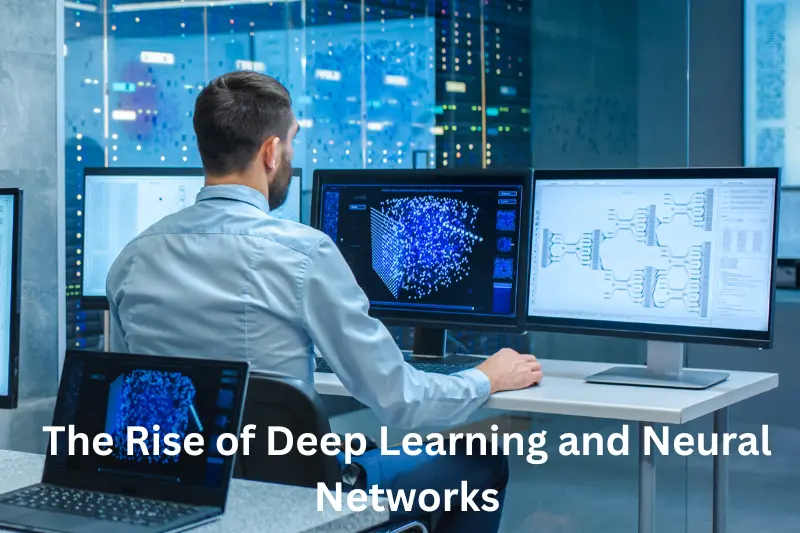In recent years, technology has been advancing at a breakneck pace, with artificial intelligence (AI) at the forefront of these innovations. One of the most transformative elements within AI is machine learning—a field that allows systems to learn from data and improve their performance without being explicitly programmed. As we move further into the future, machine learning is becoming an essential tool across industries, driving automation, efficiency, and innovation in ways we never thought possible.
So, what are the key machine learning trends we need to watch for in the coming years? From breakthroughs in neural networks to the rise of automated machine learning (AutoML), the trends are numerous and captivating. Let’s dive into the latest developments and explore how they are reshaping the world around us.
The Rise of Deep Learning and Neural Networks

Deep learning and neural networks have been at the heart of many of the most significant breakthroughs in machine learning. These technologies mimic the way the human brain works, allowing machines to process vast amounts of data and learn from it in highly advanced ways.
Improved performance
Deep learning algorithms continue to outperform traditional machine learning models, especially when dealing with unstructured data like images, audio, and video.
Self-learning capabilities
These systems are able to improve their performance without human intervention, making them highly efficient for complex tasks such as speech recognition, image processing, and even language translation.
Transforming industries
Deep learning is used in healthcare for diagnostic purposes, in autonomous vehicles for navigation, and in entertainment for recommendation systems. This trend is only set to grow as technology improves.
Automated Machine Learning (AutoML)
One of the most exciting machine learning trends of recent years is the rise of AutoML. As machine learning has become more accessible to a wider audience, the complexity of building and deploying models has been a barrier for many businesses and individuals.
Simplifying machine learning
AutoML platforms allow non-experts to create machine learning models with minimal coding or statistical knowledge. These tools automate time-consuming processes such as data cleaning, feature engineering, and model selection.
Faster implementation
With AutoML, companies can deploy machine learning models in a fraction of the time it would take to manually build them. This reduces time-to-market and allows for quicker experimentation with AI applications.
Enhancing productivity
AutoML is enabling businesses to focus more on innovation rather than the technical details of model development. It is particularly beneficial in sectors like finance, marketing, and healthcare, where AI adoption is still growing.
Natural Language Processing (NLP) and Chatbots
Natural Language Processing (NLP) has made significant strides in recent years, enabling machines to better understand, interpret, and generate human language.
Conversational AI
Chatbots and virtual assistants, powered by NLP, are becoming commonplace in customer service, retail, and various other sectors. They can engage in meaningful conversations with users, answer questions, and provide personalized experiences.
Sentiment analysis
NLP is now capable of understanding the emotions behind text data, which is invaluable in applications like social media monitoring, customer feedback analysis, and even political sentiment tracking.
Language translation
With advances in NLP, language translation tools are becoming more accurate, breaking down language barriers across borders and enabling better global communication.
Explainable AI (XAI)
As machine learning models become more complex, understanding the reasoning behind their decisions has become a growing concern. Explainable AI (XAI) is the answer to this challenge.
Transparency in decision-making
XAI aims to make machine learning models more transparent and interpretable to human users. This is especially important in sectors like finance, healthcare, and law, where decisions made by AI can have significant consequences.
Building trust in AI
By providing clear explanations for AI decisions, organizations can help build trust in their systems. This is crucial for industries that rely heavily on regulatory compliance and ethical standards.
Opening doors for adoption
As XAI systems become more accessible, businesses can implement AI solutions more confidently, knowing that they can monitor and explain the decisions made by these systems.
Reinforcement Learning in Real-World Applications
Reinforcement learning (RL) is a type of machine learning where agents learn by interacting with their environment and receiving rewards or penalties for their actions. It has gained significant attention due to its applications in real-world scenarios.
Autonomous systems
RL has been used extensively in autonomous vehicles, drones, and robots, allowing them to learn from their environment and make decisions on their own.
Game-playing AI
Famous for its role in games like AlphaGo and OpenAI’s Dota 2 bot, RL continues to showcase its potential by solving complex problems in dynamic environments.
Optimization
RL is being used in supply chain management, marketing optimization, and personalized recommendation systems, where it can help companies improve efficiency and user satisfaction.
Ready to stop wondering and start knowing? Let’s dive in.
New Laptops 2025: Experience Power Like Never Before
Gadget Comparisons You Need Before Buying Anything
Uncover the Latest Tech News That’s Changing Everything
Must-See Tech Industry Updates You Can’t Miss
Machine Learning in Edge Computing

Edge computing is revolutionizing how data is processed by bringing computational power closer to the source of data generation, rather than relying on centralized cloud servers.
Real-time analysis
By processing data locally, edge computing allows for faster decision-making and real-time analysis, which is especially beneficial for applications like autonomous vehicles, IoT devices, and industrial automation.
Reduced latency
Edge computing minimizes latency, which is crucial in scenarios where every millisecond counts, such as remote healthcare diagnostics or autonomous driving.
Security and privacy
With data being processed closer to its source, sensitive information does not need to be transmitted over long distances, reducing the risk of cyberattacks and enhancing data privacy.
AI Ethics and Bias Mitigation
As AI becomes more embedded in our daily lives, the need for ethical considerations grows. One of the primary concerns is bias in machine learning models.
Bias detection and correction
Developers are increasingly focused on ensuring that their machine learning models do not perpetuate societal biases, whether based on race, gender, or socioeconomic status.
Fairness in AI
The development of frameworks for fair AI ensures that algorithms make decisions based on equitable criteria and avoid unfair discrimination against marginalized groups.
Ethical standards
As the use of AI expands, so do the discussions around the ethical implications of machine learning. Governments, businesses, and researchers are working together to establish guidelines and standards to ensure AI is used responsibly.
Machine Learning in Healthcare
Healthcare is one of the industries that stands to benefit most from machine learning trends.
Diagnostic accuracy
Machine learning models are now being used to assist in diagnosing diseases like cancer, heart disease, and neurological disorders by analyzing medical images, patient records, and genetic data.
Predictive analytics
By analyzing historical data, machine learning can help predict patient outcomes, potential health risks, and treatment responses, improving the quality of care.
Personalized medicine
With machine learning, treatments and medications can be tailored to individual patients based on their genetic makeup, lifestyle, and medical history, ensuring more effective healthcare solutions.
The Impact of Quantum Computing on Machine Learning
Quantum computing holds the potential to revolutionize machine learning by solving complex problems much faster than classical computers.
Faster processing power
Quantum computers can process vast amounts of data in parallel, enabling machine learning models to be trained more quickly and efficiently.
Improved algorithms
Quantum machine learning algorithms are being developed that promise to improve the accuracy and speed of predictions, making them a game-changer for industries that rely heavily on big data analysis.
New possibilities
With quantum computing, tasks that were previously considered too complex or time-consuming for traditional computers—such as simulating molecular interactions or solving optimization problems—become feasible.
Future Machine Learning Trends: What’s Next?
As we look ahead, the future of machine learning promises even more exciting advancements. Some of the key trends to watch include:
Augmented Intelligence
While AI continues to evolve, it will increasingly work alongside humans to augment their decision-making abilities rather than replace them entirely.
Federated Learning
This approach enables machine learning models to be trained across multiple devices without transferring data to centralized servers, making it more secure and privacy-friendly.
AI for Sustainability
Machine learning is being used to optimize energy consumption, reduce waste, and improve sustainability efforts across various industries, helping businesses move toward more eco-friendly practices.
Conclusion:
In conclusion, the machine learning trends we’ve explored here highlight the profound impact that this technology is having across industries, from healthcare to autonomous vehicles. As machine learning continues to evolve, its capabilities are only set to increase, offering new opportunities for businesses and individuals alike. The future of AI is not just about the technology itself but how it can enhance human potential and shape the world in exciting, innovative ways. Keep an eye on these developments, as they will undoubtedly influence the next generation of breakthroughs in machine learning. Machine learning trends are here to stay, and their influence will only grow stronger in the years to come.
FAQs
What are the current machine learning trends to watch for in 2025?
Some of the top machine learning trends include advancements in deep learning, the rise of AutoML tools, the increasing focus on explainable AI (XAI), and the integration of reinforcement learning in various applications.
How does deep learning differ from traditional machine learning?
Deep learning models, which are based on artificial neural networks, can automatically learn from large amounts of unstructured data like images or audio, whereas traditional machine learning requires more manual feature engineering and is typically used for simpler tasks.
What is AutoML and how does it benefit businesses?
AutoML is a tool that automates many aspects of machine learning model development, allowing businesses to create and deploy AI models without needing deep technical expertise. It saves time, reduces complexity, and enhances productivity.
How is machine learning transforming the healthcare industry?
Machine learning is revolutionizing healthcare by improving diagnostic accuracy, predicting patient outcomes, and enabling personalized medicine. These technologies help doctors make better decisions, leading to improved patient care and more efficient operations.
Will quantum computing affect the future of machine learning?
Yes, quantum computing holds the potential to greatly enhance machine learning capabilities by processing data at much faster speeds and solving complex problems that classical computers struggle with, opening up new possibilities in AI research and applications.




